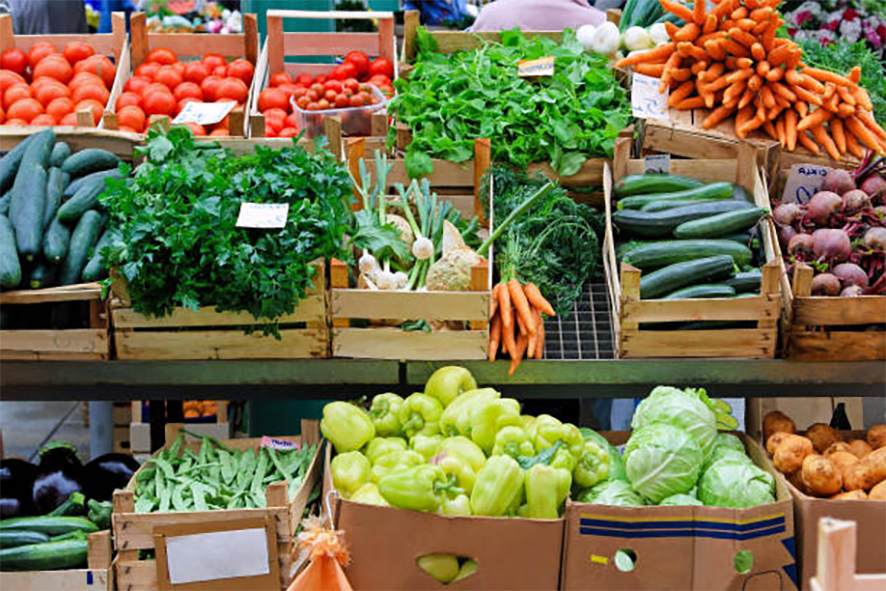FabulousFusionFood's Vegetable-based Recipes 50th Page
 A vegetable market stall.
A vegetable market stall.
Welcome to FabulousFusionFood's Vegetable-based Recipes Page — The exact definition of "vegetable" may vary simply because of the many parts of a plant consumed as food worldwide—roots, stems, leaves, flowers, fruits, and seeds. The broadest definition is the word's use adjectivally to mean "matter of plant origin". More specifically, a vegetable may be defined as "any plant, part of which is used for food", a secondary meaning then being "the edible part of such a plant". A more precise definition is "any plant part consumed for food that is not a fruit or seed, but including mature fruits that are eaten as part of a main meal". Falling outside these definitions are edible fungi (such as edible mushrooms) which, although not parts of plants, are often treated as vegetables.
The word vegetable was first recorded in English in the early 15th century. It comes from Old French, and was originally applied to all plants; the word is still used in this sense in biological contexts. It derives from Medieval Latin vegetabilis "growing, flourishing" (i.e. of a plant), a semantic change from a Late Latin meaning "to be enlivening, quickening". The meaning of "vegetable" as a "plant grown for food" was not established until the 18th century. In 1767, the word was specifically used to mean a "plant cultivated for food, an edible herb or root". The year 1955 saw the first use of the shortened, slang term "veggie".
As an adjective, the word vegetable is used in scientific and technical contexts with a different and much broader meaning, namely of "related to plants" in general, edible or not—as in vegetable matter, vegetable kingdom, vegetable origin, etc.
In the definition of "vegetable", which is used in everyday language, the words "fruit" and "vegetable" are mutually exclusive. "Fruit" has a precise botanical meaning, being a part that developed from the ovary of a flowering plant. This is considerably different from the word's culinary meaning. While peaches, plums, and oranges are "fruit" in both senses, many items commonly called "vegetables", such as aubergines, bell peppers, squashes and tomatoes, are botanically fruit.
Vegetables play an important role in human nutrition. Most are low in fat and calories but are bulky and filling. They supply dietary fibre and are important sources of essential vitamins, minerals, and trace elements. Particularly important are the antioxidant vitamins A, C, and E. When vegetables are included in the diet, there is found to be a reduction in the incidence of cancer, stroke, cardiovascular disease, and other chronic ailments. Research has shown that, compared with individuals who eat less than three servings of fruits and vegetables each day, those that eat more than five servings have an approximately twenty percent lower risk of developing coronary heart disease or stroke. The nutritional content of vegetables varies considerably; some contain useful amounts of protein though generally they contain little fat, and varying proportions of vitamins such as vitamin A, vitamin K, and vitamin B6; provitamins; dietary minerals; and carbohydrates.
The consumption of crunchy and hard to chew foods, such as raw vegetables, during youth, while the bones are still growing, is needed for the human's, and other animals', jaws' proper development, and without their consumption, the jaws do not grow to their full size, thus not leaving enough room for the teeth to grow in correctly, causing crooked and impacted teeth.
The recipes presented here are either vegetable-based or have a significant vegetable component.
The alphabetical list of all the Vegetable-based recipes on this site follows, (limited to 100 recipes per page). There are 4931 recipes in total:
Page 50 of 50
| Yetakelt W'et (Spiced Vegetable Stew) Origin: Djibouti | Yum Yum Cakes Origin: England | Zelnik (Macedoniqn Spinach Pie) Origin: Liechtenstein |
| Yétissé de Poisson (Fish Yetisse) Origin: Mali | Zürcher Eintopf (Zürich Style Hotpot) Origin: Switzerland | Zimbabwean Sorpotel Origin: Zimbabwe |
| Yiouvarlakia Souppa (Meatball Soup) Origin: Cyprus | Zaatar Mankoushe (Lebanese Zaatar Pizza) Origin: Lebanon | Zimbabwean Sutlach Origin: Zimbabwe |
| Yoghurt and Honey Pancakes with Citrus Fruit Origin: Britain | Zafrig (Soup Thickening Base) Origin: Croatia | Zimbabwean Sweet Potato Biscuits Origin: Zimbabwe |
| Yoghurt Chutney Dipping Sauce Origin: Zimbabwe | Zagrebački krumpir (Zagreb Potatoes) Origin: Croatia | Zom (Bitter Greens with Meat) Origin: Cameroon |
| Yoghurt Mint Dip Origin: Britain | Zakysanou Smetanou Polévka z Krkonoš (Sour Cream Soup from the Giant Mountains) Origin: Czech | Zupa di Pesce (Seafood Soup) Origin: Cayman Islands |
| Yorkshire Oatcakes Origin: England | Zamé Origin: Mali | Zupa Pomidorowa (Polish Tomato Soup) Origin: Poland |
| Ysgwydd Cig Oen Cymreig wedi ei bobi'n araf â chyri (Slow-cooked curried shoulder of Welsh Lamb) Origin: Welsh | Zambian Chapati Origin: Zambia | Zupa Szczaiona (Sorrel Soup with Sour Cream) Origin: Poland |
| Ysgwydd Oen Mewn Dull Gwledig (Rustic Lamb Shoulder Roast) Origin: Welsh | Zambian Mopane Worms Relish Origin: Zambia | Πλατσέντα Λέσβου (Lesbos Placenta) Origin: Greece |
| Yuk Gae Jang (Spicy Beef and Vegetable Soup) Origin: Korea | Zanzibar Pilau Origin: Tanzania | |
| Yuletide Fruit Bread Origin: England | Zarzuela de Mariscos (Seafood Zarzuela) Origin: Spain |
Page 50 of 50